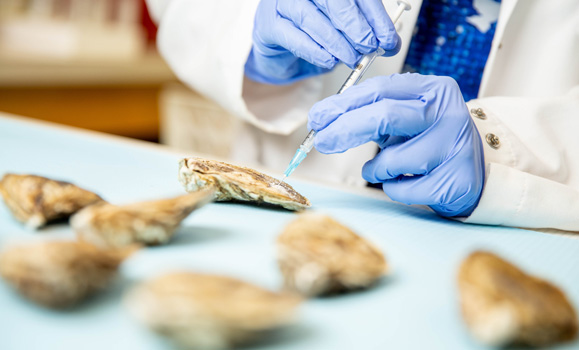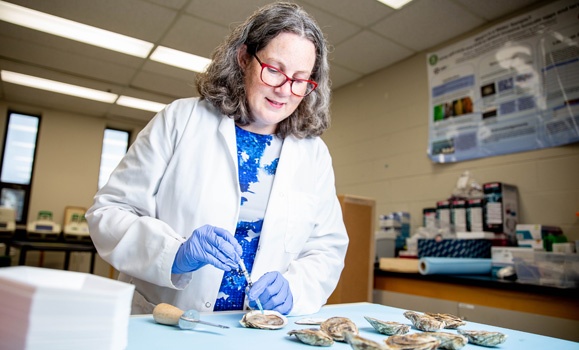There are few farms that likely could sustain themselves if 50 to 70 percent of all the seeds they planted failed to grow into marketable product. But those are the failure rates that shellfish farmers are experiencing across the Maritime Provinces as they continue to rely on larval shellfish produced by wild oysters for their seeds.
“Seed was always plentiful in the wild, so you could set out your ropes and collect a lot of larvae looking for somewhere to settle each year, which means the industry never invested in developing it,” explains Sarah Stewart-Clark, associate professor, shellfish aquaculture, with the Department of Animal Science and Aquaculture at the Faculty of Agriculture. “But climate change has had an impact on that activity, changing the location of larvae or killing many off. And the seed is becoming more variable, which means a significant percentage do not have the optimal genetics to make it through the production cycle. As a result, farmers are starting to invest in hatcheries because the traditional source of seed is unstable.”
However, the move to hatcheries requires reliable seed that can grow into reliable broodstocks – the mature shellfish that create the larvae. This is where Stewart-Clark’s expertise comes into play. She is combing through billions of genetic sequences to identify the traits that will enable farmers throughout the region to develop shellfish broodstocks that have the metabolic and respiratory efficiency to thrive on the bare minimum of resources and thus direct any excess energy to withstanding the impacts of climate change and other threats.
“In all other crops, we've found the genotypes that do well on farms, and that's all we're growing,” she says. “Through my work, I’m identifying the characteristics that will enable oysters and mussels to grow quickly and well so that they all reach maturity without any wasted resources.”
Success will not only ensure the sustainability of the Maritime Province’s shellfish farms but also significantly enhance the quality and quantity of each farm’s yield. But identifying the traits that enable shellfish to thrive requires considerable testing. Using the Aquatron Laboratory at ąű˝´ĘÓƵ’s main campus, Stewart-Clark is exposing mussels and oysters to salinity, temperature, food availability, and ocean acidification-related stressors to see which genes are more active. The insights she gathers will provide farmers with tools for assessing and monitoring the health of their seed and broodstocks.
“Shellfish do not exhibit signs of stress, so a population that looks perfectly healthy one day could be dead the next day,” Stewart-Clark says. “Now, it will be possible for farmers to determine whether their broodstocks are experiencing stress and then intervene or make more informed farming decisions. For example, if your broodstock is experiencing stress due to high temperatures or low oxygen, you can delay any actions that might increase that stress, such as moving them.”
 Although shellfish farming lags other industries in terms of selective breeding, it does have an advantage in that it is able to draw on the lessons learned by those industries, specifically finfish, in the development of reliable genotypes. Stewart-Clark says that when salmon were first selectively bred, the focus was on fast growth, resulting in fish that are unable to cope with low oxygen stress. “Because we were aware of that challenge, we were able to breed for a suite of traits—fast growth, disease resistance, resilience—to ensure that our stock can withstand a variety of conditions. And now we have the markers for those traits them.”
Although shellfish farming lags other industries in terms of selective breeding, it does have an advantage in that it is able to draw on the lessons learned by those industries, specifically finfish, in the development of reliable genotypes. Stewart-Clark says that when salmon were first selectively bred, the focus was on fast growth, resulting in fish that are unable to cope with low oxygen stress. “Because we were aware of that challenge, we were able to breed for a suite of traits—fast growth, disease resistance, resilience—to ensure that our stock can withstand a variety of conditions. And now we have the markers for those traits them.”
Stewart-Clark has already put these markers to the test. Through a collaboration with Dr. Denise Methe at DFO Gulf, Master of Science student, Stephanie Hall, and industry partner Maison Beausoleil, a New Brunswick oyster farm, she screened broodstock for metabolic and respiratory efficiency-related genes. She identified a pool of oysters with these markers and took them, along with some slower-growing oysters, back to the lab to conduct genetic sequencing and breeding tests. She also conducted genetic sequencing of the fast-growing oysters’ offspring and determined that they had the same markers.
“Our industry partner grew spat produced by broodstock with our target genetic traits,” Stewart-Clark says. “The growth rate was significantly faster than that of both the wild seed harvested on their farm and the seed we produced from oysters that did not have our target traits. Our partner estimated that using this broodstock would enable him to get oysters to the market one to two years earlier than using wild seed. This is a huge advantage for them.”
As her research continues, Stewart-Clark is filling in more gaps in our knowledge about shellfish and identifying new genes that play a prominent role in how they respond to stress. All these insights serve one purpose: to provide the industry with the best seed possible. “My role is to ensure that the industry remains sustainable by giving our farmers access to the research and development expertise they need to continue producing a world-renowned product,” she says.
Recent News
- Holiday Hours
- From Academia to Agriculture: Former PhD student and supervisor launch innovative vertical farming venture
- Community Representative ‑ Animal Care and Use
- New Face on Campus
- Sowing Seeds of Knowledge: A Gardener’s Journey with DeAnne Pelchat
- ąű˝´ĘÓƵ Advising Summit
- Legacy Awards 2024
- Fall Food Drive

